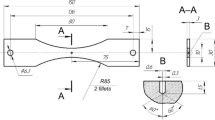Abstract
A cumulative damage analysis is presented based on damage curves derived in Ben-Amoz (2003) as bounds on mean fatigue damage in constant amplitude cycling. A detailed analysis is developed for two-stage high-low (H-L) and low-high (L-H) cycling based on single and two-mode bounds. The use of single-mode bounds is questionable as neither bound reflects a crack tip process whereas two-mode bounds reflect the actual process by the presence of both slip and opening-mode damage in each cycle. This leads to results in much closer agreement with experimental data. It is found that to ensure damage irreversibility in L-H cycling the presence of four discrete microstructure barriers obtained in Ben-Amoz (2003) is essential. As a result, two distinct sets of bounds apply: one for H-L another for L-H cycling. The barriers divide the fatigue process into three distinct macro stages while the entire range of lifetimes is divided into five ranges. In L-H cycling different sets of bounds apply to each interval between barriers, hence to each range of lifetimes. A statistical analysis based on an assumed log normal distribution of lifetimes is developed for two-stage H-L and L-H cycling. The bounds lead in a straightforward manner to a median while the variance can only be bracketed by the two-mode and single-mode variances due to exclusion of cyclic hardening as an additional random variable. Predicted residual lifetimes are in close agreement with experimental data in several metals notwithstanding the paucity of data. The two-stage analysis is then generalized to multi stage cycling.
Similar content being viewed by others
References
Ben-Amoz, M. (2003) Bounds on Fatigue Damage: Relation to Microstructure Dependent Crack Growth. International Journal of Fracture 124(3-4), 153–177.
Hashin, Z. (1983) Statistical Cumulative Damage Theory for Fatigue Life Prediction. Journal of Applied Mechanics 50, 571–579.
Subramanyan, S. (1976) A Cumulative Damage Rule Based on the Knee Point of the S-N Curve. Journal of Engineering Materials and Technology 98, 316–321.
Miller, K.J. and Zachariah, K.P. (1977) Cumulative Damage Laws for Fatigue Crack Initiation and Stage I Propagation. Journal of Strain Analysis 12(4), 262–270.
Miller, K.J. and Ibrahim, M.F.E. (1981) Damage accumulation during Initiation and Short Crack Growth regimes. Fatigue of Engineering Materials and Structures 4(3), 263–277.
Author information
Authors and Affiliations
Rights and permissions
About this article
Cite this article
Ben-Amoz, M. Cumulative damage analysis based on fatigue damage bounds. International Journal of Fracture 129, 75–96 (2004). https://doi.org/10.1023/B:FRAC.0000038877.33559.dc
Issue Date:
DOI: https://doi.org/10.1023/B:FRAC.0000038877.33559.dc




